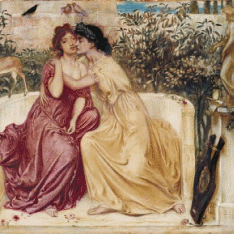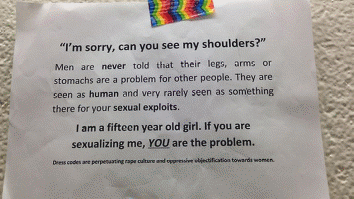Attitudes Toward Sex Positivity
Several months ago, I attended a play party at the invitation of a friend of mine. The meeting aimed to popularize the idea of sex positivity and overcome complexes through entertaining conversations and quizzes. At this party, all those present were gifted with the same T-shirts as shown in Figure 1 (“32 gifts for the sex-positive people,” 2020). Immersed in this environment, I decided to pay more attention to studying the issue of sex positivity and its manifestations and limitations in modern society.

The choice of the T-shirt as an artifact for analysis was driven by my desire to explore the relationship between sex positivity and well-being, including both physical and mental states. The denial of sexuality as a natural human property is a trend in many modern cultures. Nevertheless, personal preferences and sovereignty, as the integral aspects of human experiences, are shaped in a free social environment with no critical restrictions and constraints. In this regard, I wanted to find out how sex-positive behavior influenced one’s worldviews and whether people without sexual prejudice are more open and freer.
Based on the analysis of the topic under consideration, I have come to the conclusion that sex positivity correlates with a normal psyche and influences the worldview positively. Wacker (2018) draws a parallel between the release of dopamine, the hormone responsible for pleasure and feelings of love, and cognitive development and notes that people who experience sexual emotions regularly are prone to mental harmony. However, despite this information, in today’s society, sex-positive behavior is often condemned. According to Alexander (2018), in many cultures, the manifestation of diverse sexual expressions is unacceptable due to the existing stereotypes and obsolete values. Overcoming these barriers is a normal step towards building a healthier society in which the interests of all people are taken into account.
The participation in that play party was a valuable experience for me, and in the future, I intend to expand my knowledge regarding the positive impact of sex positivity on human health. I will attend more of these events and learn about the experiences of people facing prejudice. After that, I intend to compile the findings into a holistic study and identify the corresponding relationships. If my example is useful to someone, my work will not be in vain. I believe society is on the way to realizing that attitudes towards sex positivity should not depend on classical ideas about morality and can be a part of the modern world as its natural component.
Relationships and Sexuality
The discussion of relationships and sexuality in the context of diverse sexual expression encompasses a wide range of people’s cultural background. While attending an exhibition at the museum, which was organized by representatives of the LGBT community, I saw how rich art could be. Some works unknown to the general public evoke vivid emotions and empathy, and one of the paintings that I remember best is shown in Figure 2 (Palumbo, 2020). This 19th-century canvas shows that human love has no limits and boundaries, and beauty and sexuality have many forms. Therefore, I decided to study aspects of intimate relationships from the standpoint of sexuality and modern morals.

The presented artifact was chosen because it clearly demonstrated the freedom of human sexuality that existed in the past. Artists demonstrated the beauty of the human body in its natural form, which was the main purpose of art. This was interesting for me to compare such an approach with the modern one, and the considered painting has proved that diverse sexual expression was not an unusual phenomenon in the past. History knows examples of same-sex love, but modern society has begun to pay attention to this only recently, although, both earlier and today, representatives of sexual minorities need recognition and understanding. As a result, classical representations of sexuality and relationships expressed in art emphasize the existence of different forms of love.
While studying this theme, I have found that the topic of human sexuality has been one of the most frequent for many centuries. Moreover, nude and revealing images have always been a natural part of art, including both women and men. For instance, Song (2018) cites Raoux’s painting in which a man admires a naked woman. In the modern world, due to stereotypes, many people are not inclined to show their feelings openly. At the same time, as history shows, admiration for sexuality is part of human nature. Therefore, I have realized that with the development of society, many principles have transformed, giving way to more complex and limiting morals.
I intend to continue my immersion in the historical aspects of human relationships. Artistic examples can be a valuable background to study, and I want to collect a number of works supporting the idea that diverse sexual expression was the norm in the vision of artists from past eras. This will allow me to prove that human nature has always been multifaceted, and the uniqueness of each person, including one’s sexuality, should not be condemned.
Discrimination, Oppression, Prejudice, and Erotophobia
The issues of sexual discrimination and oppression are pressing social gaps that need to be addressed to ensure more open and unbiased relationships among people. While at a conference on sexual positivity, I saw a sticker that gained wide popularity on the Internet and became one of the symbols of the fight against gender discrimination. It is shown in Figure 1, and this sticker presented in Figure 3 carries deep meaning reinforced by open-ended questions to society and, in particular, to the male population (Downey, 2018). Written by a 15-year-old girl, this message reflects existing biased social norms that oppress women and deny freedom and gender equality.

While studying the topic of discrimination, my choice fell on this artifact for a number of reasons. When I attended the conference, I heard different people’s opinions and stories about their negative experiences of objectification and oppression based on gender. The sticker put on by a teenage girl carries an acute issue – society is not ready to accept equality as a basis and supports gender stereotypes manifested in condemnation and prohibitions. An example of a female dress code proves this form of bias. Therefore, my goal was to identify the negative manifestations of such behavior and the consequences of prejudice experienced at an early age.
When considering the proposed problem, I have highlighted several critical findings. In their study, Rye et al. (2019) present erotophobia as one of the consequences of conservatism manifested in social bias and sexual oppression. A person, being brought up within the framework of constant restrictions and restraints, can grow up with complexes, which, in turn, may affect the psyche and the perception of sexuality as a natural phenomenon. In addition, as Rye et al. (2019) state, the behavior that is based on oppression is often associated with an attempt to impose individual values on other groups. This is contrary to human nature and cannot be realized due to distinctive views of self-identity. Thus, dress code discrimination, as shown on the sticker, is unacceptable.
In the future, I plan to learn more about how to combat discriminatory stereotypes and oppression based on social prejudices. I look forward to studying primary sources, including the autobiographies of prominent feminist authors, to assess their experiences and challenges. In addition, I hope that I will be able to convey to my environment the idea of the inadmissibility of imposing individual views on others, and I will prepare enough materials to substantiate my position.
Understanding Sex Positivity Across the Human Lifespan
Sex positivity across the lifespan is a topic that has gained popularity in recent years because, in the past decades, little attention was paid to studying the sexuality of people of different ages. I was fortunate to visit a special sex-positive space – a store where customers could see and purchase unique art objects, both modern and classic, related to the theme of diverse sexual expression. In this store, I remember the photo shown in Figure 4 (“Do older people lose interest in sex,” n.d.). An older couple captured on it demonstrates that age is not a deterrent to attraction to each other, and across the lifespan, people can and want to express their feeling.

This photo has been chosen by me from a number of other artifacts because it clearly emphasizes that sex positivity can be a lifelong phenomenon, be it adolescence or, conversely, older adulthood. When looking at this shot, one can note that the elderly couple has retained an interest in each other, proving that the concepts of sexuality and relationships are not lost at this age. Moreover, maintaining such behavior throughout life is a consequence of stable attitudes. Therefore, analyzing how society perceives sex positivity across the lifespan is a learning goal.
Through studying the relevant literature, I have confirmed my idea that relationships that do not fit into the framework of traditional forms are perceived ambiguously. For instance, Mosher (2017) argues that older adults demonstrating open sexuality are often marginalized due to the fact that their position seems abnormal to others. The same applies to other age groups, whose relationships are often discussed in a negative way. Burnes et al. (2017) note that, although there are sexuality education programs in adolescence, society perceives teenagers’ sex positivity as an unacceptable phenomenon. This is generally accepted that people in young adulthood and midlife periods are the freest and the least condemned. Nevertheless, this position is associated with bias and contradicts the idea of equality.
I plan to focus more on sex positivity across the lifespan and prepare materials to make a comparative assessment of the perception of individual age groups. I am confident that I will be able to provide enough arguments to substantiate the position that the age is not an objective reason for being condemned for holding views on sexuality and relationships. In the future, I intend to convey this idea to my social environment so that as many people as possible could rethink their views on this issue.
Conclusion
All the four presented artifacts reflect my study of the topic of diverse sexual expression in the context of different environments and social conditions. This, in turn, has allowed me to draw valuable conclusions about the existing constraints and ambiguities. Sex positivity, as a natural phenomenon of human nature, is often condemned, although normal cognitive development largely depends on whether a person can express one’s sexuality or not. Moreover, obsolete morals do not provide an opportunity to popularize the idea of free views on such aspects as sexuality and relationships. At the same time, historical examples prove that the manifestation of feelings and emotions has always been a part of humanity. Both in art and in real life, one can recall diverse sexual expressions, including traditional and non-traditional forms of love. Therefore, the rejection of this truth is a significant social gap.
Regarding the topic of discrimination and oppression, the lack of freedom in the manifestation of individuality, for instance, the dress code, is a consequence of entrenched stereotypes. Moreover, some dangerous implications, such as erotophobia, can develop against the background of complexes due to the social condemnation or non-acceptance of specific behavioral forms. In general, sex positivity across the lifespan has a number of ambiguous aspects since only certain age periods are perceived with an open mind. However, being a natural part of human life, sexuality and relationships are manifested at any age, be it a teenager or an older adult. The study of these artifacts has allowed me to highlight valuable findings and controversial nuances that deserve further analysis. Researching the topic of diverse sexual expression is a relevant task that makes it possible to understand the modern psychology of the masses and help in overcoming obsolete views on the forms of sex positivity.
References
32 gifts for the sex-positive people in your life [2020 edition]. Web.
Alexander, A. A. (2019). Sex for all: Sex positivity and intersectionality in clinical and counseling psychology. Journal of Black Sexuality and Relationships, 6(1), 49-72. Web.
Burnes, T. R., Singh, A. A., & Witherspoon, R. G. (2017). Graduate counseling psychology training in sex and sexuality: An exploratory analysis. The Counseling Psychologist, 45(4), 504-527. Web.
Do older people lose interest in sex? Ten myths of ageing – Debunked. (n.d.). WordPress. Web.
Downey, M. (2018). The Atlanta Journal-Constitution. Web.
Mosher, C. M. (2017). Historical perspectives of sex positivity: Contributing to a new paradigm within counseling psychology. The Counseling Psychologist, 45(4), 487-503. Web.
Palumbo, J. (2020). This Victorian painting depicting two women in love was nearly lost in history. CNN. Web.
Rye, B. J., Merritt, O. A., & Straatsma, D. (2019). Individual difference predictors of transgender beliefs: Expanding our conceptualization of conservatism. Personality and Individual Differences, 149, 179-185. Web.
Song, B. (2018). Art, science, and technology of human sexuality. Arts, 7(1), 6. Web.
Wacker, J. (2018). Effects of positive emotion, extraversion, and dopamine on cognitive stability‐flexibility and frontal EEG asymmetry. Psychophysiology, 55(1), e12727. Web.